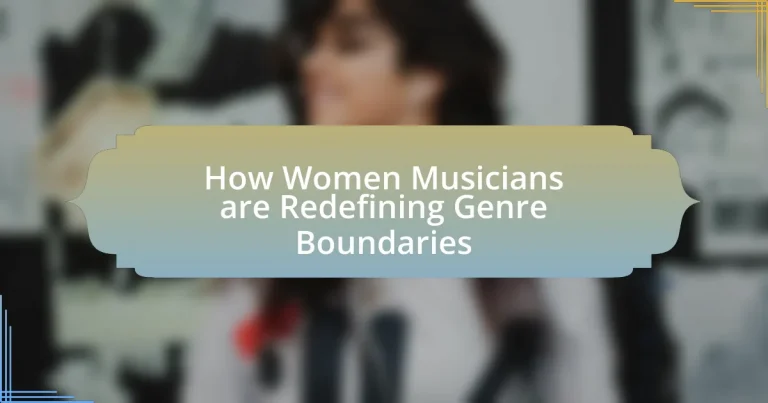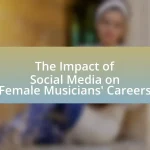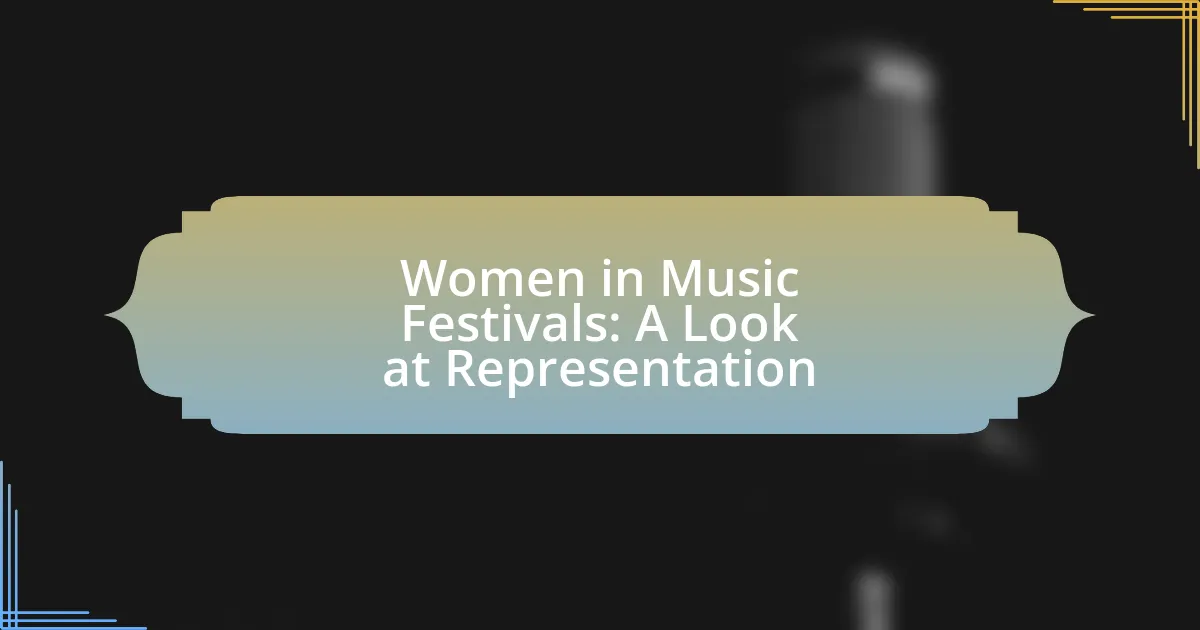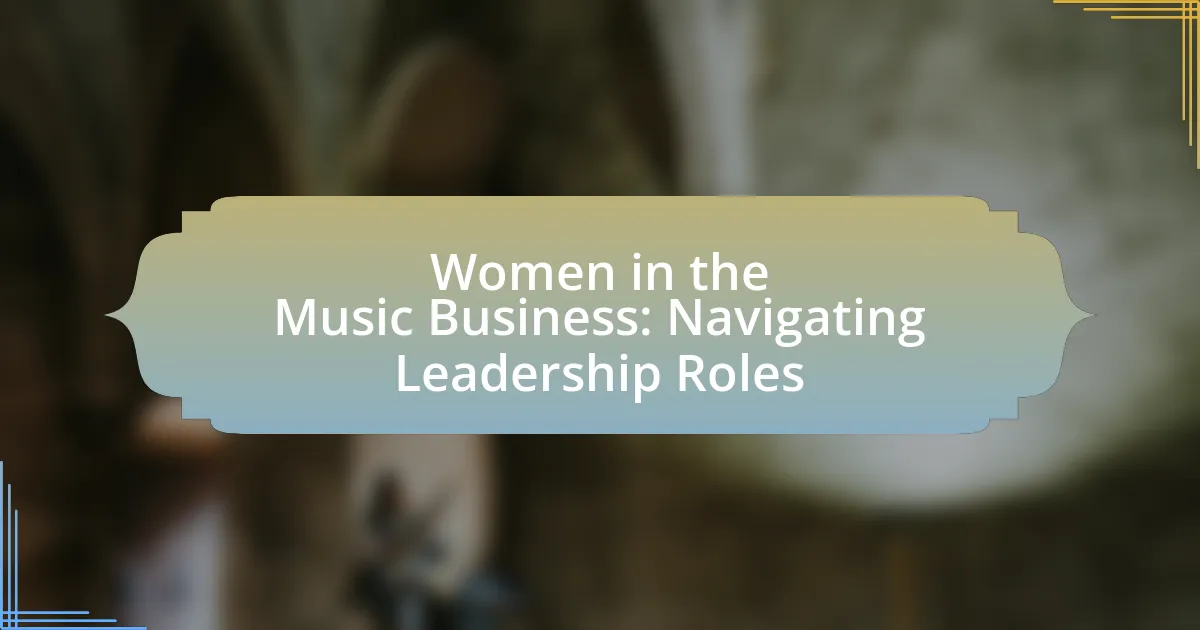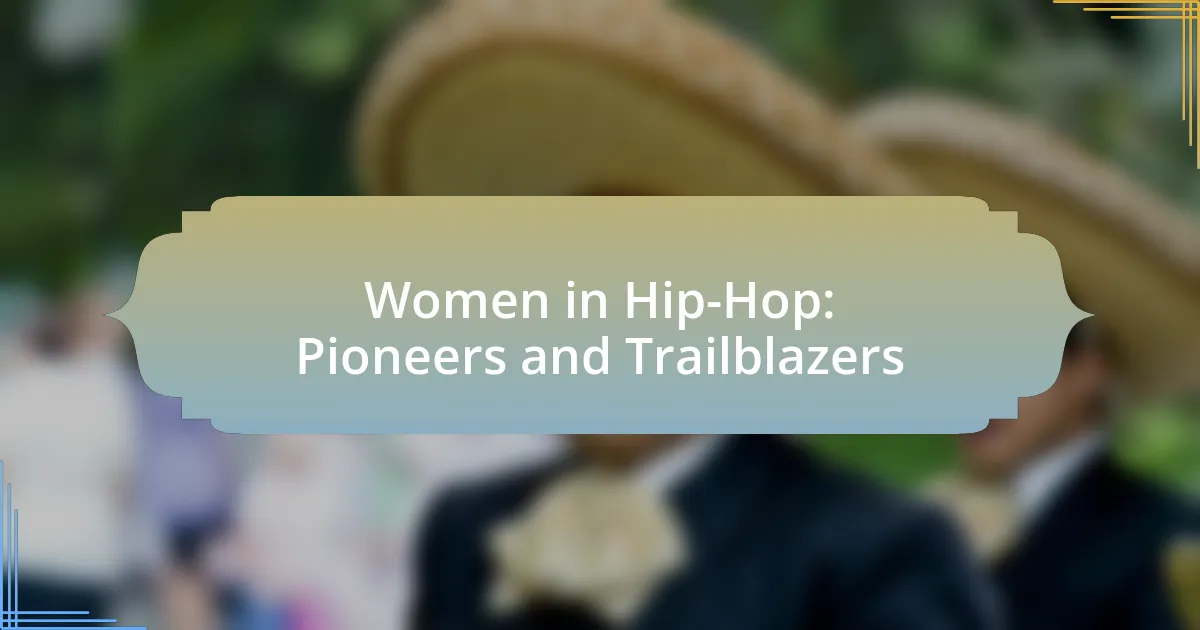Women musicians are significantly redefining genre boundaries by blending various musical styles and challenging traditional norms within the music industry. Artists such as Billie Eilish and Lizzo exemplify this trend by merging genres like pop, hip-hop, and electronic music, which not only showcases their versatility but also reflects broader cultural shifts. The article explores the characteristics of genre boundaries, the historical context of women’s involvement in music, and the challenges they face, including industry biases and stereotypes. It also highlights the importance of support systems, collaborations, and initiatives aimed at promoting gender equality and innovation in music genres. Through these discussions, the article emphasizes the transformative role of women musicians in reshaping the musical landscape.
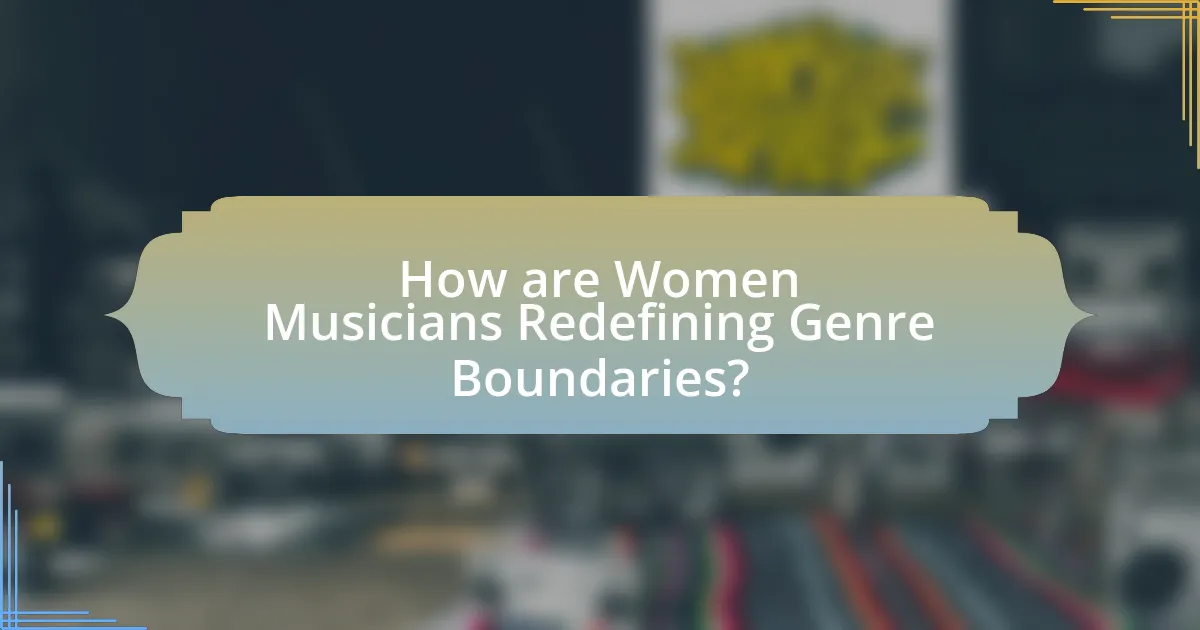
How are Women Musicians Redefining Genre Boundaries?
Women musicians are redefining genre boundaries by blending diverse musical styles and challenging traditional norms. For instance, artists like Billie Eilish incorporate elements of pop, electronic, and indie music, creating a unique sound that transcends conventional genre classifications. Similarly, Lizzo merges hip-hop, R&B, and pop, promoting body positivity and self-acceptance while expanding the sonic landscape. This genre-blending approach not only showcases their versatility but also reflects broader cultural shifts, as women increasingly assert their creative agency in the music industry. The rise of platforms like Spotify and social media further facilitates this genre fluidity, allowing women musicians to reach wider audiences and experiment with their sound without the constraints of traditional genre labels.
What are the key characteristics of genre boundaries in music?
Genre boundaries in music are characterized by distinct stylistic elements, cultural contexts, and audience expectations. These boundaries define the classification of music into categories such as rock, jazz, hip-hop, and classical, each with unique instrumentation, rhythms, and lyrical themes. For instance, rock music typically features electric guitars and a strong backbeat, while jazz emphasizes improvisation and complex harmonies. Cultural contexts also play a significant role; genres often emerge from specific social movements or historical periods, influencing their sound and message. Audience expectations further reinforce these boundaries, as listeners often seek particular experiences associated with each genre. The fluidity of these characteristics allows for genre blending, which has been increasingly evident as artists, particularly women musicians, experiment across traditional genre lines, thus challenging and redefining established boundaries.
How do genre boundaries influence musical creativity?
Genre boundaries influence musical creativity by providing both constraints and opportunities for innovation. Musicians often navigate these boundaries to blend styles, leading to the creation of hybrid genres that reflect diverse influences. For instance, artists like Billie Eilish combine elements of pop, electronic, and indie music, showcasing how crossing genre lines can result in unique soundscapes. This blending not only expands artistic expression but also challenges traditional norms, encouraging a more inclusive musical landscape. The rise of genre-fluid artists highlights the dynamic nature of music, where creativity thrives on the interplay between established genres and new, emerging forms.
What traditional genres are most commonly challenged by women musicians?
Women musicians most commonly challenge traditional genres such as rock, country, and hip-hop. In rock music, female artists have historically faced barriers, yet figures like Joan Jett and Lita Ford have redefined the genre by asserting their presence and influence. In country music, artists like Kacey Musgraves and Maren Morris have pushed against the genre’s conventional norms, advocating for inclusivity and diverse narratives. In hip-hop, women like Nicki Minaj and Cardi B have not only gained commercial success but have also challenged the male-dominated landscape by addressing themes of empowerment and sexuality. These examples illustrate how women musicians are actively reshaping and redefining genre boundaries.
Why is the role of women musicians significant in this transformation?
The role of women musicians is significant in the transformation of genre boundaries because they challenge traditional norms and introduce innovative styles that reshape musical landscapes. Women musicians, such as Billie Eilish and Lizzo, have successfully blended genres like pop, hip-hop, and electronic music, demonstrating versatility and creativity that push the limits of conventional classifications. Their influence is evidenced by the rise of genre-blurring collaborations and the increasing recognition of female artists in award shows, where women now dominate categories that were once male-dominated. This shift not only diversifies the music industry but also empowers future generations of female musicians to explore and redefine their artistic identities.
What historical context has shaped women’s involvement in music genres?
Women’s involvement in music genres has been shaped by historical contexts such as societal norms, cultural movements, and the feminist movement. In the early 20th century, women faced significant barriers in the music industry, often relegated to roles as performers rather than composers or bandleaders. The rise of jazz in the 1920s saw women like Billie Holiday and Ella Fitzgerald gain prominence, challenging gender norms and expanding opportunities for female musicians. The feminist movements of the 1960s and 1970s further propelled women’s participation in various genres, advocating for equal representation and recognition. This historical backdrop has led to a gradual but significant transformation in the music landscape, allowing women to redefine genre boundaries and assert their creative voices across diverse musical styles.
How have societal changes impacted women’s roles in music?
Societal changes have significantly expanded women’s roles in music by promoting gender equality and increasing opportunities for female musicians. The feminist movements of the 1960s and 1970s challenged traditional gender norms, leading to greater representation of women in various music genres, including rock, hip-hop, and country. For instance, the rise of female artists like Joan Jett and Madonna not only broke barriers but also inspired subsequent generations of women to pursue careers in music. Additionally, the advent of social media has allowed women to gain visibility and build audiences independently, further reshaping the music landscape. According to a 2020 report by the Annenberg Inclusion Initiative, women comprised only 21.6% of artists in popular music, highlighting ongoing challenges, yet the increasing presence of women in music festivals and award nominations indicates a positive trend towards inclusivity.
What are some notable examples of women musicians breaking genre boundaries?
Notable examples of women musicians breaking genre boundaries include Billie Eilish, who blends pop, electronic, and alternative influences, and Shakira, who fuses Latin, pop, and rock elements. Eilish’s debut album “When We All Fall Asleep, Where Do We Go?” showcases her unique sound, earning her multiple Grammy Awards and redefining contemporary pop music. Shakira’s crossover success with hits like “Hips Don’t Lie” demonstrates her ability to merge diverse musical styles, appealing to a global audience. Additionally, Björk is known for her innovative approach, combining electronic, classical, and avant-garde music, which has influenced countless artists across genres. These musicians exemplify how women are reshaping the music landscape by transcending traditional genre limitations.
How have artists like Björk and Janelle Monáe redefined their genres?
Björk and Janelle Monáe have redefined their genres by blending diverse musical styles and incorporating innovative visual and performance elements. Björk’s work, particularly in albums like “Homogenic” and “Vespertine,” merges electronic music with orchestral arrangements, challenging traditional pop structures and exploring themes of nature and technology. Janelle Monáe, through her concept albums such as “The ArchAndroid” and “Dirty Computer,” fuses funk, soul, and hip-hop while addressing social issues like identity and empowerment, thus expanding the boundaries of R&B and pop. Both artists utilize avant-garde aesthetics in their music videos and live performances, further pushing genre limits and influencing a new generation of musicians.
What impact do collaborations between women musicians have on genre blending?
Collaborations between women musicians significantly enhance genre blending by fostering innovative musical expressions that transcend traditional boundaries. These partnerships often combine diverse influences, resulting in unique sounds that challenge genre conventions. For instance, the collaboration between artists like Billie Eilish and Rosalía merges pop with flamenco, creating a fresh auditory experience that appeals to a broader audience. Additionally, research indicates that female collaborations often prioritize emotional authenticity and storytelling, further enriching the genre-blending process. This dynamic not only broadens the scope of musical genres but also encourages inclusivity and diversity within the music industry.
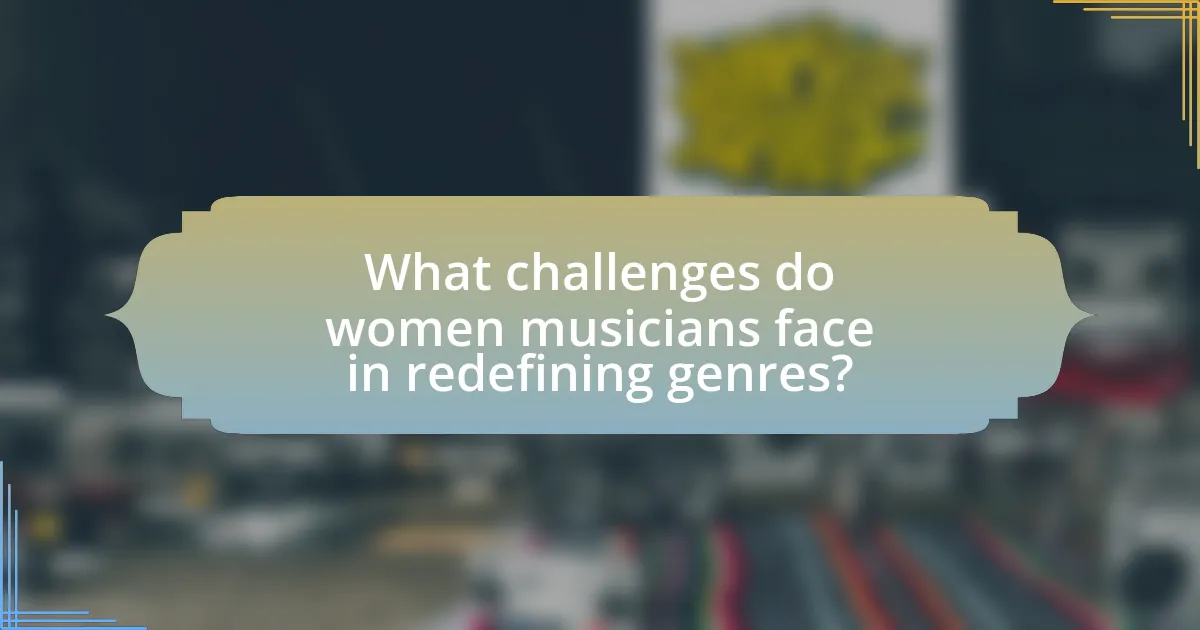
What challenges do women musicians face in redefining genres?
Women musicians face significant challenges in redefining genres, primarily due to systemic gender biases and a lack of representation in the music industry. These biases manifest in limited access to resources, opportunities, and platforms that are often dominated by male counterparts. For instance, a study by the Annenberg Inclusion Initiative found that only 22.4% of artists across popular music genres were women, highlighting the disparity in visibility and influence. Additionally, women often encounter stereotypes that pigeonhole them into specific genres, making it difficult to innovate or cross traditional boundaries. This lack of support and recognition can stifle creativity and discourage women from pursuing genre-defying projects.
How do industry biases affect women musicians’ genre exploration?
Industry biases significantly restrict women musicians’ genre exploration by perpetuating stereotypes that confine them to specific musical styles. For instance, women are often pigeonholed into genres like pop or country, limiting their opportunities to experiment with rock, hip-hop, or electronic music. Research from the University of Southern California’s Annenberg Inclusion Initiative found that only 22.4% of artists across the top charts were women, indicating a systemic bias that discourages genre diversity for female musicians. This bias not only affects the visibility of women in various genres but also influences their creative choices, as they may feel pressured to conform to industry expectations rather than pursue innovative or diverse musical expressions.
What stereotypes do women musicians encounter in the music industry?
Women musicians encounter several stereotypes in the music industry, including assumptions about their musical abilities, expectations regarding their appearance, and biases regarding their roles within bands or as solo artists. These stereotypes often suggest that women are less skilled than their male counterparts, leading to underrepresentation in genres like rock and electronic music, where they are frequently viewed as less credible. Additionally, women are often pressured to conform to specific looks or behaviors that align with traditional femininity, which can overshadow their musical talent. Research from the University of Southern California’s Annenberg Inclusion Initiative highlights that only 22.4% of artists on the Billboard Hot 100 from 2012 to 2017 were women, illustrating the systemic barriers they face.
How do these biases limit opportunities for genre innovation?
Biases limit opportunities for genre innovation by reinforcing traditional norms and expectations that often exclude diverse voices, particularly those of women musicians. These biases manifest in industry practices, media representation, and audience perceptions, which prioritize established genres and male-dominated narratives. For instance, research indicates that women are frequently underrepresented in music production roles, leading to a lack of female perspectives in genre-defining processes. This exclusion stifles creativity and experimentation, as innovative ideas from women are less likely to be recognized or supported. Consequently, the perpetuation of these biases creates a cycle that hinders the evolution of musical genres and restricts the potential for groundbreaking contributions from women artists.
What support systems exist for women musicians in genre innovation?
Support systems for women musicians in genre innovation include mentorship programs, funding initiatives, and collaborative networks. Organizations like Women in Music and She Shreds provide resources, networking opportunities, and educational workshops specifically aimed at empowering women in the music industry. Additionally, grants from entities such as the National Endowment for the Arts support projects led by women musicians, fostering innovation in various genres. Research indicates that women-led initiatives significantly enhance visibility and opportunities for female artists, thereby contributing to genre innovation.
How do mentorship and networking contribute to overcoming challenges?
Mentorship and networking significantly contribute to overcoming challenges by providing guidance, support, and access to resources. Women musicians often face unique obstacles in the industry, such as gender bias and limited opportunities. Mentorship offers them insights from experienced professionals, helping to navigate these challenges effectively. For instance, a study by the Berklee College of Music found that mentorship can enhance career development and increase confidence among female musicians. Networking expands their connections, leading to collaborations and visibility, which are crucial for success in a competitive field. This combination of mentorship and networking empowers women musicians to break genre boundaries and establish their presence in the music industry.
What role do music festivals and organizations play in supporting women musicians?
Music festivals and organizations play a crucial role in supporting women musicians by providing platforms for visibility, networking opportunities, and resources tailored to their needs. These events often feature female artists prominently, helping to challenge gender stereotypes in the music industry. For instance, festivals like Lilith Fair and organizations such as Women in Music have historically focused on promoting female talent, leading to increased representation and recognition. Research indicates that festivals with diverse lineups not only enhance the visibility of women musicians but also contribute to their career advancement, as seen in the rise of female headliners at major events over the past decade.
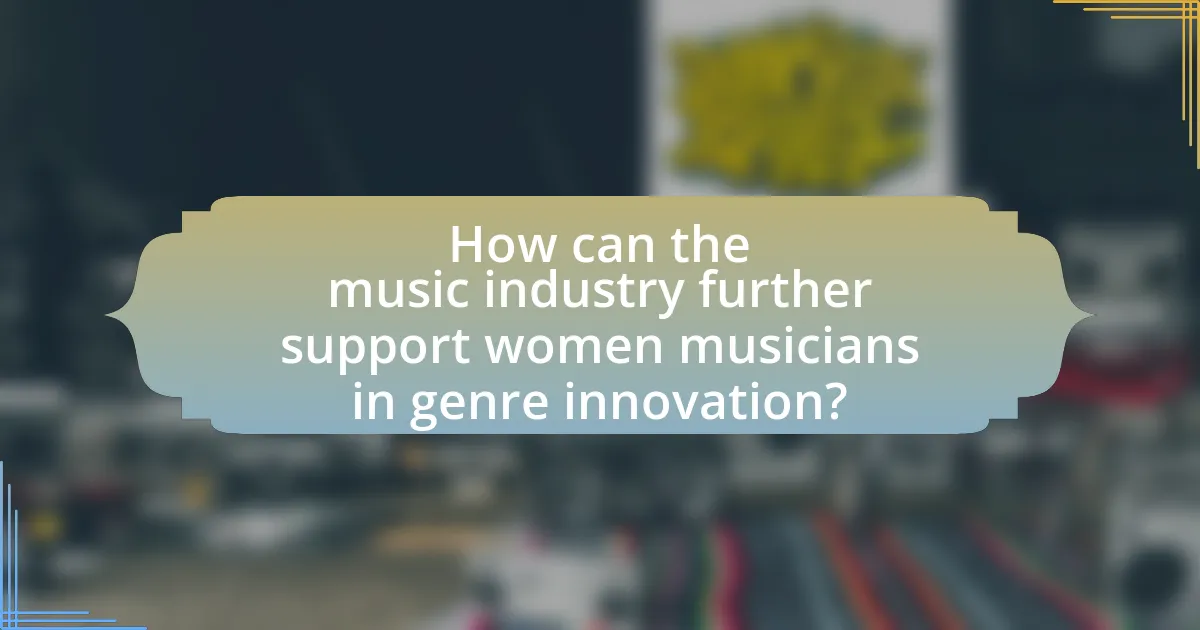
How can the music industry further support women musicians in genre innovation?
The music industry can further support women musicians in genre innovation by providing increased funding and resources specifically aimed at female artists. Research indicates that women receive significantly less funding for music projects compared to their male counterparts, which limits their ability to experiment and innovate within genres. For instance, a study by the Annenberg Inclusion Initiative found that only 22.4% of artists in popular music are women, highlighting the need for targeted initiatives. By establishing grants, mentorship programs, and dedicated platforms for women musicians, the industry can create an environment that fosters creativity and encourages genre-blending. Additionally, promoting female-led collaborations and showcasing their work in festivals and media can amplify their visibility and influence in genre innovation.
What initiatives can promote gender equality in music genres?
Initiatives that can promote gender equality in music genres include mentorship programs, equitable funding opportunities, and inclusive music festivals. Mentorship programs connect emerging female artists with established musicians, fostering skill development and industry knowledge. Equitable funding opportunities ensure that women-led projects receive financial support, addressing the historical funding gap; for instance, studies show that women receive only a fraction of music industry funding compared to their male counterparts. Inclusive music festivals that prioritize female artists not only provide performance opportunities but also challenge gender biases in programming, as seen in festivals that have implemented gender parity policies.
How can record labels create more inclusive environments for women musicians?
Record labels can create more inclusive environments for women musicians by implementing equitable hiring practices and providing mentorship programs. Research indicates that women represent only 21% of artists in the music industry, highlighting the need for systemic changes. By actively recruiting women for key roles in production, management, and creative teams, labels can foster diverse perspectives and support female artists more effectively. Additionally, mentorship initiatives can connect emerging women musicians with established industry professionals, facilitating knowledge transfer and career advancement. Studies show that mentorship significantly increases retention and success rates for women in male-dominated fields, reinforcing the importance of these programs in the music industry.
What policies can be implemented to encourage genre diversity?
To encourage genre diversity, policies should include funding for diverse music programs, promoting equitable access to resources for underrepresented artists, and implementing mentorship initiatives that connect emerging musicians with established professionals across various genres. Funding for diverse music programs can be evidenced by initiatives like the National Endowment for the Arts, which supports projects that foster artistic innovation and cultural diversity. Promoting equitable access ensures that artists from different backgrounds can participate in the music industry, as seen in programs like the Women’s Audio Mission, which provides training and resources specifically for women and gender-expansive individuals. Mentorship initiatives, such as those offered by organizations like She Is The Music, facilitate connections that can lead to genre-blending collaborations, further enhancing diversity in music.
What practical steps can aspiring women musicians take to redefine genres?
Aspiring women musicians can redefine genres by actively experimenting with diverse musical styles and incorporating elements from various genres into their work. This approach allows them to create unique sounds that challenge traditional genre classifications. For instance, artists like Billie Eilish blend pop with electronic and alternative influences, showcasing how genre fusion can lead to innovative music. Additionally, women musicians should collaborate with artists from different backgrounds and genres, as seen in the partnerships between artists like Lizzo and various hip-hop and pop musicians, which further expands genre boundaries. Engaging with technology, such as music production software and social media platforms, enables women to share their genre-defying music widely, reaching broader audiences and influencing the music landscape.
How can women musicians leverage social media for genre exploration?
Women musicians can leverage social media for genre exploration by utilizing platforms to share diverse musical styles and collaborate with artists from various genres. Social media allows them to reach a global audience, enabling the discovery of niche genres and fostering cross-genre collaborations. For instance, platforms like Instagram and TikTok have been instrumental in promoting genre-blending music, as seen with artists like Lizzo and Billie Eilish, who incorporate elements from pop, hip-hop, and electronic music. This exposure not only broadens their artistic horizons but also engages listeners who appreciate innovative sounds, thus redefining genre boundaries in the music industry.
What resources are available for women musicians to develop their unique sound?
Women musicians can access various resources to develop their unique sound, including mentorship programs, online courses, and collaborative platforms. Organizations like Women in Music and She Shreds provide networking opportunities and educational resources tailored for female artists. Additionally, platforms such as SoundBetter and BandLab facilitate collaboration with other musicians and producers, allowing women to experiment with different styles and techniques. Research indicates that mentorship significantly enhances creative development; for instance, a study by the Berklee College of Music found that women who participated in mentorship programs reported increased confidence and skill in their musical endeavors.
